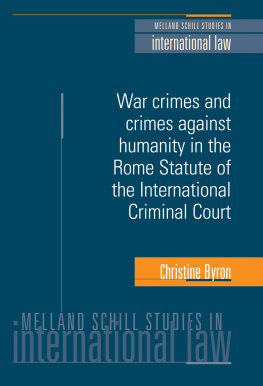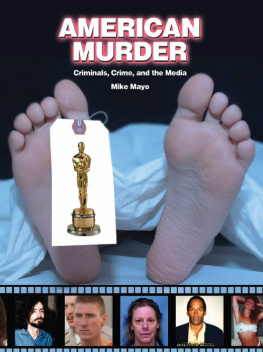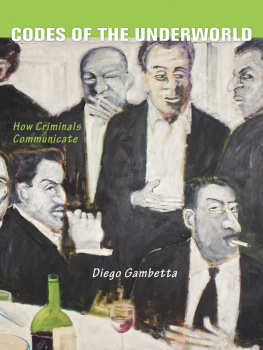Different Crimes Different Criminals
Understanding, Treating and Preventing Criminal Behavior
Doris Layton Mackenzie, Ph.D.
Lauren ONeill
Wendy Povitsky
Summer Acevedo
University of Maryland
Different Crimes, Different Criminals: Understanding, Treating and Preventing Criminal Behavior
First published 2006 by Anderson Publishing
Published 2015 by Routledge
2 Park Square, Milton Park, Abingdon, Oxon OX14 4RN
and by Routledge
711 Third Avenue, New York, NY 10017, USA
Routledge is an imprint of the Taylor & Francis Group, an informa business
Copyright 2006
Taylor & Francis. All rights reserved.
No part of this book may be reprinted or reproduced or utilised in any form or by any electronic, mechanical, or other means, now known or hereafter invented, including photocopying and recording, or in any information storage or retrieval system, without permission in writing from the publishers.
Notices
No responsibility is assumed by the publisher for any injury and/or damage to persons or property as a matter of products liability, negligence or otherwise, or from any use of operation of any methods, products, instructions or ideas contained in the material herein.
Practitioners and researchers must always rely on their own experience and knowledge in evaluating and using any information, methods, compounds, or experiments described herein. In using such information or methods they should be mindful of their own safety and the safety of others, including parties for whom they have a professional responsibility.
Product or corporate names may be trademarks or registered trademarks, and are used only for identification and explanation without intent to infringe.
MacKenzie, Doris Layton
Different crimes, different criminals: understanding, treating and preventing criminal behavior -- 1st Ed. Doris Layton MacKenzie, Lauren ONeill, Wendy Povitsky, Summer Acevedo
Includes bibliographical references and index.
ISBN-13: 978-1-59345-334-3 (pbk)
Cover design by Tin Box Studio, Inc./Cincinnati, Ohio
EDITOR Janice Eccleston
ACQUISITIONS EDITOR Michael C. Braswell
The authors would like to thank the following professionals for their assistance in reviewing the following chapters for content and accuracy:
Bernard Auchter, Ph.D., Senior Social Science Analyst with the Violence and Victimization Research Division of the National Institute of Justice, Office of Justice Programs, U.S. Department of Justice.
James C. Howell, Adjunct Researcher at the National Youth Gang Center.
The Honorable Marvin S. Kaminetz, Circuit Court for St. Mary's County, Maryland.
David J. Kolko, Ph.D., Professor of Psychiatry, Psychology & Pediatrics, University of Pittsburgh School of Medicine and Director of Special Services Unit at the Western Psychiatric Institute and Clinic.
Dr. Martin Lalumiere, research psychologist at the Centre for Addiction and Mental Health, Associate Professor of Psychiatry and Criminology at the University of Toronto, and Associate Head of Research for the Law and Mental Health Program in the Department of Psychiatry at the University of Toronto.
Dr. D. Kim Rossmo, Texas State University Department of Criminal Justice and Dr. Eric W. Hickey, California State University, Fresno Department of Criminology.
Sally Simpson, Ph.D., Department Chair, Department of Criminology and Criminal Justice, University of Maryland, College Park, MD.
Franklin Zimring, J.D., William G. Simon Professor of Law at the University of California, Berkeley.
Table of Contents
| Doris MacKenzie |
| Jaclyn Smith |
| Jennifer Gibbs |
| Summer Acevedo |
| Danielle A. Harris |
| Ashlee Parker |
| Wendy Povitsky |
| Elizabeth Smith and Wendy Povitsky |
| Lauren O'Neill |
| Raven Korte and Susan Fahey |
| Sara Betsinger |
| Michael Kreziman and Nancy Minniti |
| Natalie Schell |
| Summer Acevedo and Lauren O'Neill |
Chapter 1
Understanding Criminals and Crime: Theory and Research
Doris Layton MacKenzie
Why do people commit crimes? Why does one person commit a certain type of crime and another person commit another? In this book we examine different types of crimes and criminals. As is evident, no one classification system or theoretical perspective adequately describes all types of crimes and criminals. Our task in this book is to examine these different types of crimes and criminals. For each, we discuss the characteristics of the offenders, theories dominating the current research on the offender or offense, and provide a critical analysis of the research. Effective methods for identifying, classifying, managing, preventing, and treating the diverse types of offenders differ dramatically. The contributing authors examine the effectiveness of various prevention strategies and treatment options for the different types of crimes and criminals. Theories, research, and classification schemes differ widely for the different offenses and offenders. That is the reason for the title of this book; it is in recognition of the many differences that exist among offenders and their crimes.
A Multidisciplinary Perspective: Sociology, Psychology, and Biology
This book demonstrates the changes that have occurred in the theoretical perspectives in criminology and criminal justice. For years, the academic discipline of criminology looked towards the social and physical environment to try to understand criminal behavior. This was, in part, a result of the domination of criminology by sociologists. Sociologists studying crime attempted to propose one theory that would explain all types of crimes. Currently, criminologists have begun to realize that these explanations for crime are not adequate to understand all of the different types of crimes and criminals. The person who commits infanticide differs greatly from the serial murderer and the arsonist who, in turn, differ from each other. Criminologists recognize that individual differences in cognitions and biology are important in understanding criminal behavior.
This book grew out of a graduate course on the topic of "Psychology and Crime ."The students were asked to select one type of crime or criminal, and examine the literature. They were asked specifically to: (1) discuss the characteristics of the offender who commits this type of crime; (2) report on the theoretical perspective that is most helpful in understanding this type of offender; (3) review the research on prevention and/or treatment of this type of offender, and (4) evaluate research on effectiveness of treatment and prevention programs. The papers submitted by the students were so outstanding that we decided to combine them in this book. Each chapter discusses the above topics in regard to a different type of crime or criminal. Chapters were reviewed by experts in the field, to ensure pertinent information was included.
A review of the different theoretical perspectives presented in the chapters clearly demonstrates that no one overall theory is adequate to describe all these offenders. Traditionally, criminologists have been trained in the field of sociology and most criminology theories have been based of this perspective. However, sociological theories do not appear adequate to explain all of these crimes. Many sociological theorists search for a general theory of crime. Indeed, one general theory of criminal behavior does not seem sufficient to understand these criminals.











